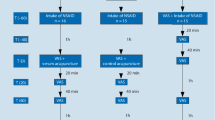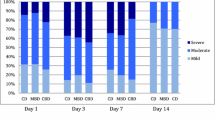Abstract
Post-tonsillectomy swallowing pain is a common and distressing side effect after tonsillectomy and thus of great clinical interest. Up until now, there is no randomized controlled patient- and observer-blinded study evaluating the efficacy of acupuncture against swallowing pain after tonsillectomy. We therefore compared the potency of specific verum acupuncture points related to a Chinese medical diagnosis in reducing postoperative swallowing pain with non-specific control points on the body as well as a non-acupuncture group who received standard medication only. The standardized pain therapy after tonsillectomy was orally administered nonsteroidal anti-inflammatory drugs (NSAID) (diclofenac 3 × 50 mg oral). The patients (n = 123) treated with NSAID were asked about their acute pain after taking a sip of water between the first and fifth postoperative day. Participants’ pain was assessed using visual analog (VAS) [zero (0) for no pain up to ten (10) for the acute reported outset pain] before and 20 min, 1, 2 and 3 h after acupuncture treatment or standard pain medication, respectively. The functional assessment of diagnosis and treatment point-combination occurred by means of the “Heidelberg Model” of Traditional Chinese Medicine (TCM). Verum acupuncture lead to a significant additional pain relief. In comparison to the acupuncture, they also reported an average of 3 h duration of adequate pain-relief past taking the NSAID. This trial strongly supports a specific acupuncture scheme for the treatment of postoperative swallowing pain after tonsillectomy. It may particularly serve as an alternative pain treatment in case of NSAID intolerances.




Similar content being viewed by others
References
Afman CE, Welge JA, Steward DL (2006) Steroids for post-tonsillectomy pain reduction: meta-analysis of randomized controlled trials. Otolaryngol Head Neck Surg 134(2):181–186
Canbay O, Celebi N, Uzun S, Sahin A, Celiker V, Aypar U (2008) Topical ketamine and morphine for post-tonsillectomy pain. Eur J Anaesthesiol 25(4):287–292
Carr MM, Williams JG, Carmichael L, Nasser JG (1999) Effect of steroids on posttonsillectomy pain in adults. Arch Otolaryngol Head Neck Surg 125(12):1361–1364
Greten HJ (2006) Kursbuch Traditionelle Chinesische Medizin—TCM verstehen und richtig anwenden Stuttgart. Georg Thieme Verlag, Germany
Huskisson EC (1974) Measurement of pain. Lancet 2(7889):1127–1131
Majer EH, Bischko J (1973) Proceedings: acupuncture analgesia in tonsillar surgery. Archiv für klinische und experimentelle Ohren-Nasen-und Kehlkopfheilkunde 205(2):280–282
O’Flaherty JE, Lin CX (2003) Does ketamine or magnesium affect posttonsillectomy pain in children? Paediatr Anaesth 13(5):413–421
Porkert M (1991) Die theoretischen Grundlagen der chinesischen Medizin. Phainon
Price DD, McGrath PA, Rafii A, Buckingham B (1983) The validation of visual analogue scales as ratio scale measures for chronic and experimental pain. Pain 17(1):45–56
Strom H (1974) Acupuncture treatment of post-tonsillectomy pain. The analgesic effect compared with blind puncture. Ugeskr Laeger 136(33):1855–1856
Acknowledgments
We thank the patients whose collaboration made this project possible.
Conflict of interest statement
The authors do not have any financial relationship with the University of Heidelberg that sponsored the research.
Author information
Authors and Affiliations
Corresponding author
Rights and permissions
About this article
Cite this article
Sertel, S., Herrmann, S., Greten, H.J. et al. Additional use of acupuncture to NSAID effectively reduces post-tonsillectomy pain. Eur Arch Otorhinolaryngol 266, 919–925 (2009). https://doi.org/10.1007/s00405-008-0851-1
Received:
Accepted:
Published:
Issue Date:
DOI: https://doi.org/10.1007/s00405-008-0851-1




